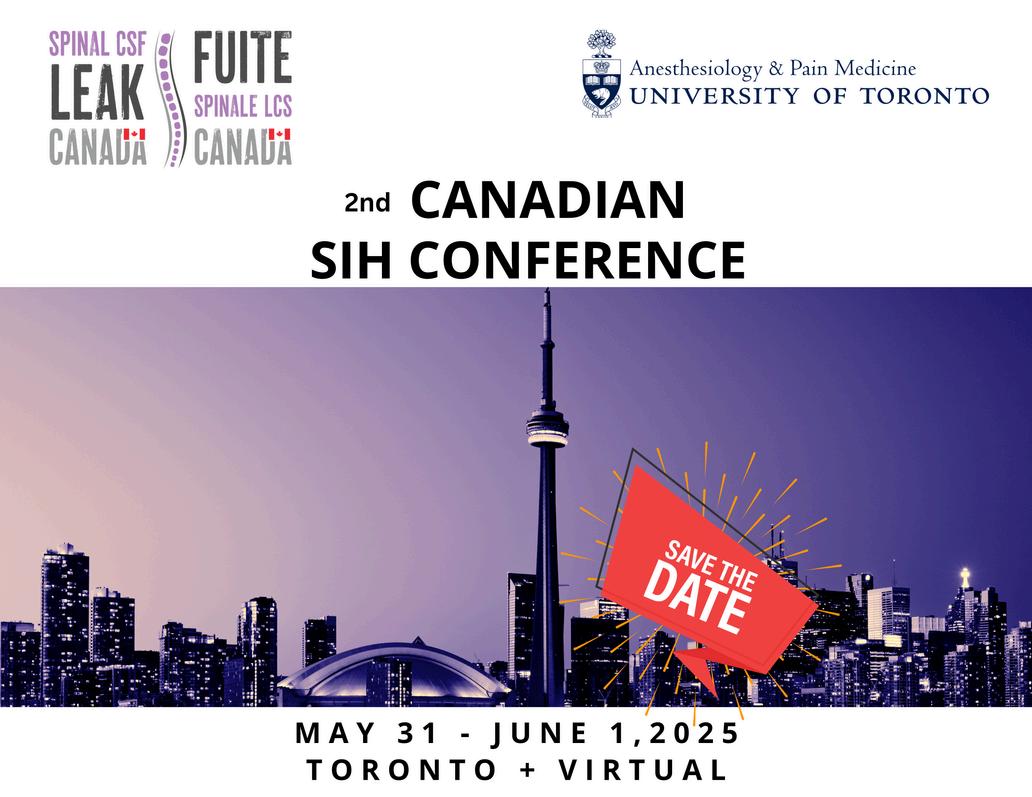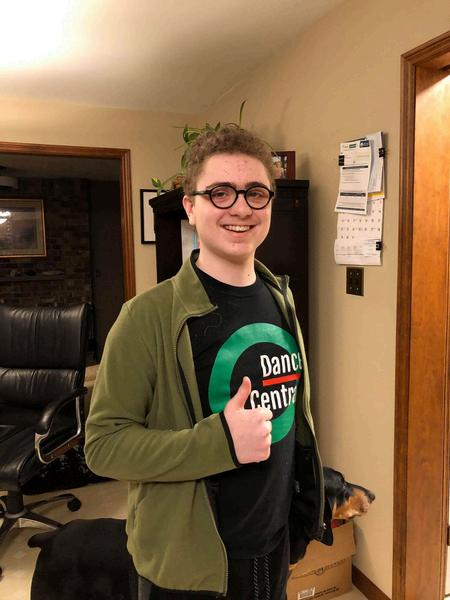

The CSF Leak Times
Message from Spinal CSF Leak Canada charitable organization
Welcome to the CSF Leak Times! We are thrilled to present the first issue of our newsletter
At Spinal CSF Leak Canada, we are committed to improving the lives of those affected by this underdiagnosed and undertreated neurological condition. Our organization has made significant strides in advocacy, research, and support, thanks to the unwavering dedication of our volunteers, donors, and supporters. This newsletter is an extension of our mission to provide education, create a strong community, and drive positive change.
In each issue, you can expect to find recent key publications, and Canadian research updates/active projects. Additionally, we will keep you updated on our upcoming educational events and opportunities, advocacy and fundraising efforts, and ways you can get involved with the charity if you are interested. Some issues may also include a feature article with a Q&A with the author and/or co-authors, offering additional insights on the topics covered, and patient or caregiver testimonials highlighting their journeys, challenges, and successes
As we launch this newsletter, we extend our deepest gratitude to our Medical Advisory Team, especially Dr. Farnaz Amoozegar, neurologist and Clinical Associate Professor at the University of Calgary, member of the Medical Advisory Team, and Chair of our Scientific Committee. Her expertise and support help ensure that we provide accurate, up-to-date information to our readers.
Some highlights of our recent activities include the creation of a spinal CSF leak referral directory (to better support physicians from any region of
November
Canada needing assistance with patient referrals), Canadian led research including a prospective study assessing patient outcomes after various interventions, ongoing data collection in our Spontaneous Intracranial Hypotension (SIH) registry, and ongoing work on Canadian SIH guidelines/practice recommendations.
Please see below for further information on these, as well as educational opportunities, including the 2nd Canadian SIH conference, and Canadawide SIH case rounds.
We hope you enjoy this newsletter!
Warm regards,
Bahareh Cloutier
Founder & Chair, Spinal CSF Leak Canada

Content
Recent key Publications/Featured Articles
List of Additional Interesting Recent Articles
Canadian Research Update/ Active Projects
Update on Recent Activities
Upcoming Educational Events
How to Get Involved and Make a Difference
Patient Testimonials
Recent key publications/Featured Articles

Long-Term Epidural Patching Outcomes and Predictors of Benefit in Patients With Suspected CSF Leak Nonconforming to ICHD-3 Criteria.
Carroll I, Han L, Zhang N, Cowan RP, Lanzman B, Hashmi S, Barad MJ, Peretz A, Moskatel L, Ogunlaja O, Hah JM, Hindiyeh N, Barch C, Bozkurt S, Hernandez-Boussard T, Callen AL Neurology 2024 Jun 25;102(12):e209449 doi: 10 1212/WNL 0000000000209449 Epub 2024 May 31
This study aimed to identify which patients with suspected cerebrospinal fluid (CSF) leaks, who do not meet the ICHD-3 criteria for spontaneous intracranial hypotension (SIH), could still benefit from epidural blood patching (EBP). A cohort of 85 patients, 74% who didn’t meet ICHD-3 criteria saw significant improvement after EBP, though response rates were higher for those meeting the criteria. The study suggests that broader eligibility for EBP could benefit more patients and highlights the need for further research to optimize treatment strategies
To read the full study, please visit: https://www.neurology.org/doi/10.1212/WNL.0000000000209449
This piece was also discussed by the author in a recent episode of the Neurology Podcast. To listen to the podcast, please visit: https://podcasts.apple.com/ca/podcast/neurology-podcast/id266288159?i=1000661927839
Optic Nerve Sheath MR Imaging Measurements in Patients with Orthostatic Headaches and Normal Findings on Conventional Imaging Predict the Presence of an Underlying CSF-Venous Fistula.
Wouter I Schievink, Marcel M Maya, Angelique Sao-Mai S Tay, Peyton L Nisson, Jay Acharya, Rachelle B Taché and Miriam Nuño
American Journal of Neuroradiology May 2024, 45 (5) 655-661; DOI: https://doi org/10 3174/ajnr A8165
In this study, authors explore the use of optic nerve sheath MR imaging to predict the presence of CSFvenous fistulas. The study found that smaller optic nerve sheath diameter and perioptic subarachnoid space measurements were strongly associated with the presence of a CSF-venous fistula. Following surgical treatment, these measurements increased significantly. The findings suggest that optic nerve sheath MR imaging can be a valuable tool in identifying patients who may need further imaging to detect CSF leaks.
To read the full study, please visit: https://www.ajnr.org/content/45/5/655
Direct comparison of digital subtraction myelography versus CT myelography in lateral decubitus position: evaluation of diagnostic yield for cerebrospinal fluid-venous fistulas.
Lützen N, Demerath T, Würtemberger U, Belachew NF, Barvulsky Aleman E, Wolf K, El Rahal A, Volz F, Fung C, Beck J, Urbach H J Neurointerv Surg 2023 Nov 2:jnis-2023-020789 doi: 10 1136/jnis-2023-020789
In this study authors compare the diagnostic yield of lateral decubitus digital subtraction myelography (LD-DSM) and lateral decubitus CT myelography (LD-CTM) for detecting cerebrospinal fluid-venous fistulas (CVFs). The study included patients with spontaneous intracranial hypotension (SIH) and CVFs who underwent both LD-DSM and LD-CTM Both imaging modalities were performed sequentially, with LD-CTM following LD-DSM Two neuroradiologists independently reviewed the results, blind to the presence of CVFs. Out of 20 patients, LD-CTM identified significantly more CVFs than LD-DSM (rater 1: 39 vs 9, P<0.001; rater 2: 42 vs 12, P<0.001). In conclusion this study demonstrates LD-CTM has a higher diagnostic yield for detecting CVFs compared to LD-DSM and should be used in conjunction with or as an alternative to LD-DSM.
To read the full study, please visit: https://www ajnr org/content/45/5/655
The last few years have been exciting for spinal CSF Leak research
A recent analysis titled: Research productivity on spontaneous intracranial hypotension: A bibliometric analysis. Jesse CM, Graf NW, Häni L, Goldberg J, Dobrocky T, Piechowiak EI, Raabe A, Schär RT. Brain Spine. 2024 Aug 30;4:103324. doi: 10.1016/j.bas.2024.103324., provides an in-depth overview of the progress in SIH research over time, illustrating how the global publication landscape has evolved
Here are some takeaways:
The average yearly growth rate of publications is 12.7%, reflecting an upward trend, although some years were less productive.
The number of patients studied also grew significantly, from just one patient in 1983 to 4,230 in 2020.
Neurology and Neurosurgery leading at 25 8% and 25 7% respectively, in publication specialty rankings
USA contributed the most articles (33.8%), followed by Japan and Italy; South Korea, Canada, and Switzerland had the highest publication density per physician.
University of Toronto was listed as a notable contributor, with six first authors publishing SIH-related research.
List of additional interesting recent articles
Patterns of clinical and imaging presentations in patients with spontaneous intracranial hypotension due to spinal cerebrospinal fluid venous fistula: A single-center retrospective cross-sectional study
Callen AL, Han L, Pisani Petrucci SL, Andonov N, Lennarson P, Birlea M, O'Brien C, Wilhour D, Anderson A, Bennett JL, Carroll IR Headache 2024 Sep;64(8):939-949 doi: 10 1111/head 14805 Epub 2024 Aug 11
To read the full study, please visit: https://headachejournal.onlinelibrary.wiley.com/doi/10.1111/head.14805
Rebound Intracranial Hypertension
Parikh, S.K. Curr Pain Headache Rep 28, 395–401 (2024). https://doi.org/10.1007/s11916-024-01231-9
To read the full study, please visit: https://link.springer.com/article/10.1007/s11916-024-01231-9
Assessing the effects of spontaneous intracranial hypotension on quality of life, work ability and disability
Kapan, A , Waldhör, T & Wöber, C Wien Klin Wochenschr (2024) https://doi org/10 1007/s00508-024-02423-4
To read the full study, please visit: https://link.springer.com/article/10.1007/s00508-024-02423-4
Spinal CSF Leaks: The Neuroradiologist Transforming Care
Mark D Mamlouk, Andrew L Callen, Ajay A Madhavan, Niklas Lützen, Lalani Carlton Jones, Ian T Mark, Waleed Brinjikji, John C Benson, Jared T Verdoorn, DK Kim, Timothy J Amrhein, Linda Gray, William P Dillon, Marcel M Maya, Thien J Huynh, Vinil N Shah, Tomas Dobrocky, Eike I Piechowiak, Joseph Levi Chazen, Michael D Malinzak, Jessica L Houk and Peter G Kranz American Journal of Neuroradiology August 2024, ajnr A8484; DOI: https://doi org/10 3174/ajnr A8484
To read the full study, please visit: https://www.ajnr.org/content/early/2024/08/29/ajnr.A8484
Non-invasive biomarkers for spontaneous intracranial hypotension (SIH) through phase-contrast
MRI
Wolf K, Volz F, Lützen N, Mast H, Reisert M, Rahal AE, Fung C, Shah MJ, Beck J, Urbach H J Neurol 2024 Jul;271(7):43364347 doi: 10 1007/s00415-024-12365-6
To read the full study, please visit: https://link.springer.com/article/10.1007/s00415-024-12365-6
Diagnostic Performance of Decubitus Photon-Counting Detector CT Myelography for the Detection of CSF-Venous Fistulas
Madhavan AA, Cutsforth-Gregory JK, Brinjikji W, Bathla G, Benson JC, Diehn FE, Eckel LJ, Mark IT, Morris PP, Payne MA, Verdoorn JT, Weber NM, Yu L, Baffour F, Fletcher JG, McCollough CH American Journal of Neuroradiology December 2023, 44 (12) 1445-1450; DOI: https://doi org/10 3174/ajnr A8040
To read the full study, please visit: https://www ajnr org/content/44/12/1445
Likelihood of Discovering a CSF Leak Based on Intracranial MRI Findings in Patients without a Spinal Longitudinal Extradural Collection: A New Probabilistic Scoring System
Benson JC, Madhavan AA, Mark IT, Cutsforth-Gregory JK, Brinjikji W, Verdoorn JT. AJNR Am J Neuroradiol. 2023 Nov;44(11):1339-1344 doi: 10 3174/ajnr A8030 Epub 2023 Oct 26
To read the full study, please visit: https://www.ajnr.org/content/44/11/1339
Diagnosis and Treatment of Spontaneous Intracranial Hypotension: Role of Epidural Blood Patching
Callen AL, Friedman DI, Parikh S, Rau JC, Schievink WI, Cutsforth-Gregory JK, Amrhein TJ, Haight E, Cowan RP, Barad MJ, Hah JM, Jackson T, Deline C, Buchanan AJ, Carroll I Neurol Clin Pract 2024 Jun;14(3):e200290 doi: 10.1212/CPJ.0000000000200290. Epub 2024 Apr 30.
To read the full study, please visit: https://www.neurology.org/doi/10.1212/CPJ.0000000000200290
Multidisciplinary consensus guideline for the diagnosis and management of spontaneous intracranial hypotension
Cheema S, Anderson J, Angus-Leppan H, Armstrong P, Butteriss D, Carlton Jones L, Choi D, Chotai A, D'Antona L, Davagnanam I, Davies B, Dorman PJ, Duncan C, Ellis S, Iodice V, Joy C, Lagrata S, Mead S, Morland D, Nissen J, Pople J, Redfern N, Sayal PP, Scoffings D, Secker R, Toma AK, Trevarthen T, Walkden J, Beck J, Kranz PG, Schievink W, Wang SJ, Matharu MS J Neurol Neurosurg Psychiatry. 2023 Oct;94(10):835-843. doi: 10.1136/jnnp-2023-331166.
To read the full study, please visit: https://jnnp.bmj.com/content/94/10/835
Spontaneous Intracranial Hypotension: 10 Myths and Misperceptions
Kranz PG, Gray L, Amrhein TJ. Headache. 2018 Jul;58(7):948-959. doi: 10.1111/head.13328.
To read the full study, please visit: https://headachejournal.onlinelibrary.wiley.com/doi/10.1111/head.13328
Canadian Research Update / Active Projects
* SIH Registry
A registry has been developed to collect information on patients diagnosed with SIH by a physician This registry is comprehensive and collects data on many factors, including clinical symptoms, exam findings, diagnostic imaging, percutaneous procedures (epidural blood patching/fibrin glue), surgical interventions, endovascular treatments, follow-up and outcomes, and care outside of province/country. The data collected is both retrospective and prospective. Currently, the Universities of Calgary and Toronto are actively recruiting patients Patients with SIH are eligible if they have been assessed at one of these centers as access to medical records is required This registry will provide a rich data set and help answer many important questions regarding SIH.
If you are a physician seeing SIH patients and are interested in becoming involved with the registry or setting it up at your center, please contact the study PI, Dr. Farnaz Amoozegar: farnaz amoozegar@ahs ca
* SIH Outcomes Study: “Prospective Observational Study “
The SIH outcomes study is a prospective longitudinal observational study that aims to assess outcomes for SIH patients treated by various interventions, including percutaneous procedures (epidural blood patching/fibrin glue), surgical interventions, and endovascular treatments. Data collection occurs prospectively by a physician and via patient reported outcomes (PROs). The physician data collection is within a separate arm of the above described SIH registry database The PROs are questionnaires that assess a number of factors including disability, quality of life, mental health, and a global assessment of change, all collected prospectively at multiple time intervals from prior to treatment to five years following treatment. This is a multicenter study involving both US and Canadian sites. Currently, Cedars Sinai medical center and the University of Calgary are actively recruiting. If you are interested in getting involved in this study, please contact the study PI, Dr Farnaz Amoozegar: farnaz amoozegar@ahs ca
Canadian Research Update / Active Projects
SIH Patient Survey
In collaboration with Spinal CSF Leak Canada, Dr Yasmine Hoydonckx, Dr. Philip Peng, and Dr. Farnaz Amoozegar, conducted a cross sectional online survey to determine Canadian patients’ experiences with receiving the diagnosis and treatments of SIH The results will soon be published in the Canadian Journal of Neurological Sciences In short, the results showed that SIH continues to be underdiagnosed or misdiagnosed, and there continues to be a significant lack of awareness in the medical community about this condition. In addition, there are long wait lists for specialists, diagnostic tests, and interventions, even once the diagnosis is made Many patients do seek care out of province or country due to lack of resources or expertise in their hometown.
Canadian SIH Guidelines
Experts across Canada from various disciplines, including neurology, anesthesiology, neuroradiology, and neurosurgery have come together to write consensus guidelines for the diagnosis and treatment of SIH in Canada This work is currently in progress. This publication will serve as an important step in spreading knowledge and awareness of this condition and should lead to more standardized practices across Canada Keep a look out for this exciting publication in the coming months
Upcoming Educational Events


The 2nd Canadian SIH Conference is scheduled for May 31 to June 1, 2025, and will be a multidisciplinary hybrid conference (in Toronto and online). The conference will feature a combination of plenary and interactive sessions, as well as workshops. This event will bring together a distinguished panel of international experts. More info will be shared soon on our website.
About Canada-Wide SIH Case Rounds for physicians: These rounds are organized by Spinal CSF Leak Canada charity, and chaired by Dr Farnaz Amoozegar. These rounds feature discussions of complex Spontaneous Intracranial Hypotension cases among experts from multiple disciplines. The next rounds are scheduled for January 23rd, 2025
If you are interested to present a case or/and join the conversation, please contact: info@spinalcsfleakcanada.ca Subject: SIH case rounds
Other Recent Activities
Canada SIH Referral Directory
Spinal CSF Leak Canada, in collaboration with the Medical Advisory Board has undertaken the initiative to create a directory that includes information on what is offered at each major center in Canada for the diagnosis and management of SIH This directory includes information on referral criteria and methods, specific physicians that may be contacted, diagnostics and specific treatments that are offered at each center, and approximate wait times. In order to access this referral directory, physicians must register. (please see link below)
Register HERE: https://www.spinalcsfleakcanada.ca/registration-form-for-physicians
If you are a physician treating patients with spinal CSF leak at your clinic or center and would like to be added to this Canada SIH Referral Directory, please complete a brief survey that we have developed to gather information about your center's resources and the current referral practices (Please see link below, to access the Survey )
https://www spinalcsfleakcanada ca/canada-sih-referral-pathway-survey
Password: SIH2024
How to Get Involved and Make a Difference

Support
Consider making a donation to support our mission No matter the size, your tax-deductible donations enable us to raise awareness, fund research, provide educational grants to physicians, improve access to care and treatment, and support patients for supporting us
ties for s to Help ness and eer patient
nterested teer/raise ease direct website
Raise Awareness



Fundraise
Organize a fundraising event or campaign to support our work. Whether it’s a bake sale, a run, or a virtual event, every effort helps us to continue with our mission.
Raise Awareness
Raise awareness about spinal CSF leaks by sharing our resources and information with your colleagues, patients and anyone interested in this condition
Follow us on social media and help spread the word by sharing our posts and updates The more people know about this condition, the greater the support and understanding for those affected

Patient Testimonials
“My life changed, physically and mentally. I couldn't go to school because my head hurt, I couldn’t think right, and I was very tired. This experience changed my perspective of life.” Sam

“When you suffer from this disease, you go through a whole range of emotions, from euphoria to discouragement and then back to hope.” Pierre

“I am so grateful for my family doctor for flagging my symptoms. I wish that the other practitioners that I saw were able to identify the very characteristic symptoms I was having of a CSF leak.” Matea
